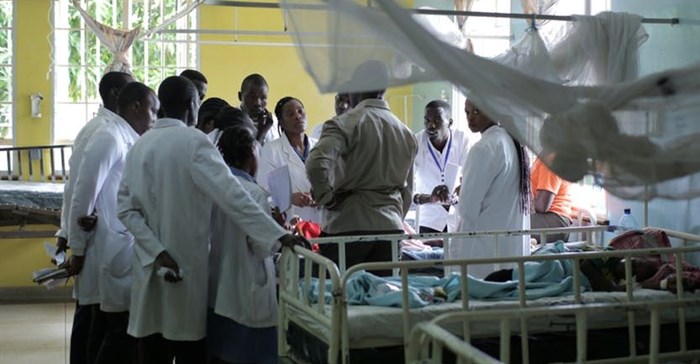Information is important for high level managers to make informed decisions. The advance of information and communication technology means that information is generated in abundance and at a fast pace. But this has led to managers facing information overload. This is particularly true in the health domain - a sector fragmented with information systems from a variety of data sources.

Doctors at a hospital in Kisumu, Kenya. Shutterstock
One way round the problem is to visually present the information from different sources on a single screen. This can enable data managers to monitor a comprehensive set of performance indicators at a glance and make informed decision.
A tool that enables this is the scorecard, or dashboard, which gives a full view of an organisation’s performance by using a “traffic light” visualisation to link short and long term goals. This concept was introduced by Robert Kaplan and David Norton in 1996 and has since been used by managers in various sectors.
I conducted a study over four years to understand how scorecards could be used in the East Africa Community to strengthen regional collaboration and address common health agendas. During the study a regional scorecard was developed, made up of indicators measuring health performance of partner states based on set targets.
The scorecard
The developed scorecard was used in the six partner states that make up the East African Community. These are Burundi, Kenya, Rwanda, South Sudan, Tanzania and Uganda.
The research was part of the larger global Health Information System Program. The initiative has been ongoing for the last 20 years and involves software development and country implementation of District Health Information Software in several countries in Africa, Asia, South America and Europe. I am part of the global network and have been engaged in implementing and evaluating health information systems in several of these projects in Africa.
The East African Community scorecard was first used to monitor maternal and child health care.
A set of indicators measuring countries’ maternal and child health care performance were selected in the design of the regional scorecard. Data populating the selected indicators were periodically pulled from the national level health information system.
For example, one indicator included in the scorecard measured the percentage of women who visit health facilities at least four times during pregnancy. This indicator was based on World Health Organisation (WHO) recommendations which have since been increased to eight visits.
The scorecard was designed and developed by regional and national health information systems experts as well as officials responsible for maternal and child health policies in the partner states’ ministries of health. The development process entails a series of face to face meetings complimented with off-site discussions. Members from health information initiatives were also part of the implementation process.
The regional scorecard measured the countries’ performance by displaying a red colour where performance was off track, a yellow colour for progress but requiring more effort, and the green colour indicating the target achieved.
The first regional scorecard was launched on 2015 in the East African Community. The event brought together ministers in the region responsible for health, selected parliamentarians, the academia and development partners.
Using a colour coded approach, the scorecard managed to capture the attention of leaders from the region by quickly identifying the indicators with poor performance as well as those that needed more drive to achieve agreed targets.
By arranging the countries together while showing their performance, the scorecard generated a competition element among leaders. For example, while progress was observed from Rwanda and Tanzania in reducing child mortality, progress towards maternal health goals was slow across the rest of the region.
This awareness prompted ministers of health and parliamentarians to commit resources to areas with lower performance.
In addition, the leaders of the East African Community endorsed the first regional scorecard, and asked for it to be produced annually.
Lessons learnt
A few useful lessons were learnt from the research. It showed that the scorecard was:
- An effective communication tool. By using the traffic light display, managers could track performance of several indicators. Its visualisation enabled information to be understood at a glance.
- Useful as the basis for performance benchmarking: understanding areas that affect the success or failure of the organisation is of a paramount importance in the management of complex system like health sector.
- A good advocacy tool. It can be used in discussions among technical and non-technical stakeholders in viewing the progress and address challenges.
Way forward
Based on the experience in East Africa Community we believe the scorecard can be useful in creating awareness among high level managers and engaging them in a broader discussion on improving the maternal and child health care. Managers can rely on the scorecard to quickly inform them of the performance of their organisation as well as what progress is being made towards a defined set of targets.
We are working on a third version of the scorecard for the East Africa community to be integrated into other health programmes such as HIV and TB.
This article is republished from The Conversation under a Creative Commons license. Read the original article.














